
The insects of the beetle family Chrysomelidae are commonly known as leaf beetles, and include over 37,000 species in more than 2,500 genera, making up one of the largest and most commonly encountered of all beetle families. Numerous subfamilies are recognized, but the precise taxonomy and systematics are likely to change with ongoing research.

Neochlamisus is a genus of leaf beetles in the tribe Fulcidacini. They are members of the case-bearing leaf beetle group, the Camptosomata. Measuring 3–4 millimeters in length as adults, they are cryptic, superficially resembling caterpillar frass. Seventeen, sometimes 18 species are presently accepted in this genus, all of them occurring in North America.

The Fulcidacini, sometimes known as the warty leaf beetles, are a tribe within the leaf beetle subfamily Cryptocephalinae, though historically they were often treated as a distinct subfamily, Chlamisinae. 11 genera with altogether about 400 species are currently placed here; some four-fifths of the species are found in the Neotropics, but the rest is distributed over all other continents except Antarctica.
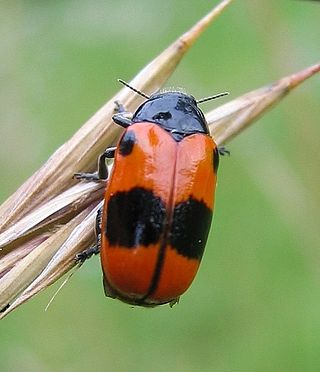
The Clytrini are a tribe within the leaf beetle subfamily Cryptocephalinae, though historically they were often treated as a distinct subfamily, Clytrinae. As the other Cryptocephalinae, they belong to the group of case-bearing leaf beetles known as Camptosomata.

The Eumolpinae are a subfamily of the leaf beetles, or Chrysomelidae. It is one of the largest subfamilies of leaf beetles, including more than 500 genera and 7000 species. They are oval, and convex in form, and measure up to 10 mm in size. Typical coloration for this subfamily of beetles ranges from bright yellow to dark red. Many species are iridescent or brilliantly metallic blue or green in appearance.
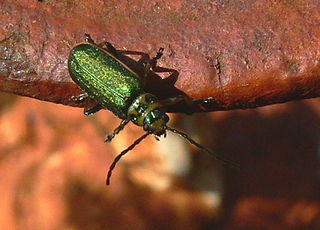
The Galerucinae are a large subfamily of the leaf beetles (Chrysomelidae), containing about 15,000 species in more than 1000 genera, of which about 500 genera and about 8000 species make up the flea beetle tribe Alticini.
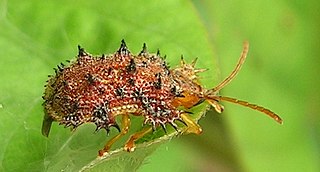
The Cassidinae are a subfamily of the leaf beetles, or Chrysomelidae. The antennae arise close to each other and some members have the pronotal and elytral edges extended to the side and covering the legs so as to give them the common name of tortoise beetles. Some members, such as in the tribe Hispini, are notable for the spiny outgrowths to the pronotum and elytra.
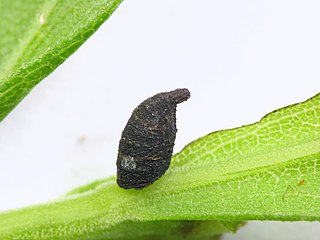
Camptosomata are the case-bearing leaf beetles or camptosomates, named for their larval habit of carrying a case of waste material. This group consists of two subfamilies of Chrysomelidae : Lamprosomatinae and Cryptocephalinae .

The Cryptocephalini are a tribe within the leaf beetle subfamily Cryptocephalinae. As the other Cryptocephalinae, they belong to the group of case-bearing leaf beetles known as Camptosomata. Some species are myrmecophilous.

Cassida is a large Old World genus of tortoise beetles in the subfamily Cassidinae. The natural history of Cassida sphaerula in South Africa is a typical life cycle. Several species of Cassida are important agricultural pests, in particular C. vittata and C. nebulosa on sugar beet and spinach. The thistle tortoise beetle has been used as a biological control agent against Canada thistle.

Lachnaia is a genus of leaf beetles in the subfamily Cryptocephalinae, tribe Clytrini. Multiple species in this genus are known to be myrmecophiles, such as the larvae of L. italica.
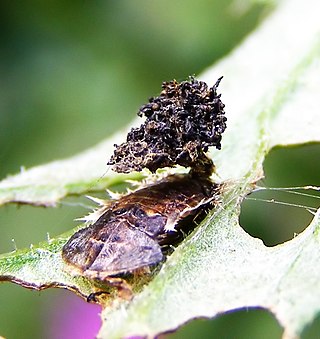
The fecal shield is a structure formed by the larvae of many species of beetles in the leaf beetle family, Chrysomelidae. It is composed of the frass of the insect and often its exuviae, or bits of shed exoskeleton. The beetle may carry the shield on its back or wield it upon its posterior end. The main function of the fecal shield is defense against predators. Other terms for the fecal shield noted in the literature include "larval clothing", "kotanhang", "faecal mask", "faecal pad", and "exuvio-faecal annex".

Proseicela is a genus of leaf beetles.
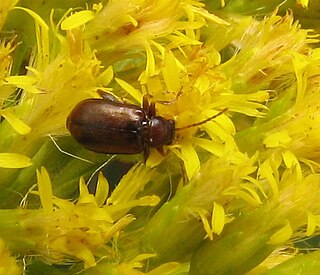
Luperaltica nigripalpis is a species of flea beetle in the family Chrysomelidae. It is found in North America.
Longitarsus melanurus is a species of flea beetle in the family Chrysomelidae. It is found in North America.
Kuschelina jacobiana is a species of flea beetle in the family Chrysomelidae. It is found in North America.

Kuschelina gibbitarsa is a species of flea beetle in the family Chrysomelidae. It is found in North America.
Disonycha balsbaughi is a species of flea beetle in the family Chrysomelidae. It is found in North America.
Systena marginalis, the margined systena, is a species of flea beetle in the family Chrysomelidae. It is found in North America.

Mylassa is a genus of case-bearing leaf beetles in the family Chrysomelidae. It is the only member of the tribe Mylassini within the subfamily Cryptocephalinae. There are seven or eight described species distributed in the southern part of South America.



















